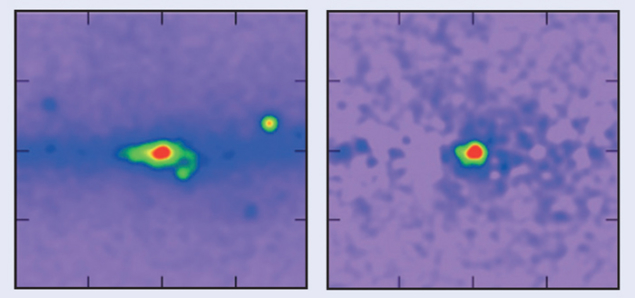
Image credit: T Daylan et al., Fermi Space Telescope, NASA.
A new analysis of observations of the galactic centre by the Fermi Gamma-ray Space Telescope strengthens the case for a signal from annihilating dark matter. The authors claim that the excess emission has a spectral shape, spatial extent and normalization in good agreement with predictions of simple models of dark-matter annihilation.
Although still elusive in particle-physics experiments, dark matter is a reality for astronomers. Its presence is implied by the fluctuations in the cosmic microwave background as measured by the Planck mission (CERN Courier May 2013 p12). It is essential for the formation of the first stars and galaxies, and it provides the additional gravitational pull to hold clusters of galaxies together. Nonetheless, dark matter is only detected indirectly, via its effect on ordinary matter, or at most through its gravitational lensing effect on background galaxies observed through a massive galaxy cluster (CERN Courier July/August 2013 p14). Weakly interacting massive particles (WIMPs) are a prime candidate for cold dark matter in the universe. With a mass above about 1 GeV and interacting only through the weak nuclear force and gravity, they can remain invisible because of their lack of electromagnetic interactions. However, the annihilation of WIMPs could potentially produce gamma rays, cosmic rays and neutrinos. Theoretical candidates for WIMPs include the lightest supersymmetric particle, neutralinos and sterile neutrinos.
As with all galaxies, the Milky Way is thought to be surrounded by a spherical halo of dark matter. The density gradient towards the galactic centre makes the latter the best place to search for a gamma-ray signal associated with dark-matter annihilation. The Fermi satellite is well suited for this search at energies between 100 MeV and 300 GeV (CERN Courier November 2008 p13). In the past few years, the analysis of Fermi’s observations of the central region of the Galaxy by different groups has detected a significant excess with a maximum emission at around 1–3 GeV.
A new analysis by a US team led by Tansu Daylan from Harvard University is now attracting attention. The team used a more restrictive selection of gamma rays, including only those with a small positional uncertainty. This allows the researchers to produce gamma-ray maps at higher resolution, enabling an easier separation of the putative spherically-symmetric dark-matter signal from the contribution of the Galaxy’s diffuse emission and the “bubbles” found by Fermi (CERN Courier January/February 2011 p11). The team finds an excess emission out to angles of around 10° from the centre of the Galaxy, with no significant deviation from spherical symmetry. The excess has a high significance and a best-fit spatial distribution following a generalized Navarro-Frenk-White halo profile, with an inner slope of γ = 1.26. Such a broad distribution disfavours the proposed alternative that this emission originates from a population of thousands of millisecond pulsars.
The derived spectrum associated with this excess is well fitted by dark-matter particles with mass 31–40 GeV annihilating to b quarks. The new study disfavours the previously considered 7–10 GeV mass window in which the dark matter annihilates significantly to τ leptons. The annihilation cross-section required to account for the signal is also found to be in good agreement with predictions for dark matter in the form of a simple thermal relic. While this analysis does not provide a discovery of dark-matter annihilation, it is nevertheless a compelling case for this process that will have to be confirmed by corroborating observations in dwarf galaxies around the Milky Way.





